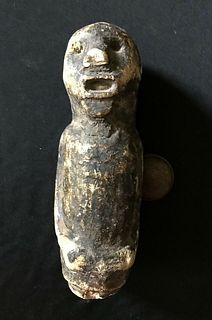13th C. Arctic Anthropomorphic Carvings (Group of 4)
Lot 146a
About Seller
Artemis Fine Arts
686 S Taylor Ave, Ste 106
Louisville, CO 80027
United States
Selling antiquities, ancient and ethnographic art online since 1993, Artemis Gallery specializes in Classical Antiquities (Egyptian, Greek, Roman, Near Eastern), Asian, Pre-Columbian, African / Tribal / Oceanographic art. Our extensive inventory includes pottery, stone, metal, wood, glass and textil...Read more
Estimate:
$3,000 - $4,500
Absentee vs Live bid
Two ways to bid:
- Leave a max absentee bid and the platform will bid on your behalf up to your maximum bid during the live auction.
- Bid live during the auction and your bids will be submitted real-time to the auctioneer.
Bid Increments
| Price | Bid Increment |
|---|---|
| $0 | $25 |
| $300 | $50 |
| $1,000 | $100 |
| $2,000 | $250 |
| $5,000 | $500 |
| $10,000 | $1,000 |
| $20,000 | $2,500 |
| $50,000 | $5,000 |
| $100,000 | $10,000 |
| $200,000 | $20,000 |
About Auction
By Artemis Fine Arts
Jul 1, 2020
Set Reminder
2020-07-01 10:00:00
2020-07-01 10:00:00
America/New_York
Bidsquare
Bidsquare : Ancient | Near-Eastern | Asian Art
https://www.bidsquare.com/auctions/artemis-gallery/ancient-near-eastern-asian-art-5276
Ancient art from Egypt, Greece, Italy and the Near East, as well as Asian, Fossils, Pre-Columbian, Native American, African / Tribal / Oceanic, Spanish Colonial, Russian Icons, Fine art, much more! Artemis Fine Arts info@artemisgallery.com
Ancient art from Egypt, Greece, Italy and the Near East, as well as Asian, Fossils, Pre-Columbian, Native American, African / Tribal / Oceanic, Spanish Colonial, Russian Icons, Fine art, much more! Artemis Fine Arts info@artemisgallery.com
- Lot Description
Native American/First Nations, found on St. Lawrence Island, Alaska, Thule culture or slightly later, ca. 1200 to 1850 CE. A quartet of incredibly rare, hand-carved ivory and wood effigy figures, each preserved for centuries in the frozen tundra. In the photos, the two to the left are walrus ivory, the other two are wood. Each figure is anthropomorphic and simple. The largest's main features are its elongated ovoid head, its dramatically-defined shoulders, narrow waist, and split legs - this one is the most recent. The others are similarly formed, with their heads the main focus and their bodies generally less defined. The one with wider legs may be intended to be a woman as it has low mounds that may represent breasts. All of these figures once may have had more decorative elements, but if so, they have been lost to time. All are displayed together in a riker box. Size of largest: 1.75" W x 6" H (4.4 cm x 15.2 cm); shadow box: 12.25" W x 8.2" H (31.1 cm x 20.8 cm)
The Thule people were the ancestors of modern Inuit whose advanced culture and technology made them a part of the global economy during what we in the West call the Medieval period. These figures were carved during a dynamic time in Thule history; recent research indicates that sometime after ca. 1200 CE, perhaps in a span of just a few years, the Thule people spread from their Bering Strait homeland all the way to Greenland, likely driven by the search for iron, both from meteoric deposits they may have heard about from the Dorset people to their east, and from trade. They traded with the Chinese to their west - metal beads and a belt buckle of Chinese manufacture and dating to 1100 to 1300 CE have been found in in the Seward Peninsula - and interacted with the Vikings to their east, who describe them in the Vinland Saga as the Skraelings.
This is an ESA antique exempt piece of ivory and cannot be sold internationally or to anyone residing in the states of California, Hawaii, Illinois, Nevada, New Hampshire, New Jersey, New York, Oregon, and Washington. We guarantee that the piece is over 100 years old.
Provenance: private Glorieta, New Mexico, USA collection
All items legal to buy/sell under U.S. Statute covering cultural patrimony Code 2600, CHAPTER 14, and are guaranteed to be as described or your money back.
A Certificate of Authenticity will accompany all winning bids.
We ship worldwide and handle all shipping in-house for your convenience.
#154065All are in nice condition with some tiny losses from peripheries, wear commensurate with age, and rich patina. The largest is the most recent and is in the best condition.Condition
- Shipping Info
-
All shipping is handled in-house for your convenience. Your invoice from Artemis Gallery will include shipping calculation instructions. If in doubt, please inquire BEFORE bidding for estimated shipping costs for individual items.
-
- Buyer's Premium



 EUR
EUR CAD
CAD AUD
AUD GBP
GBP MXN
MXN HKD
HKD CNY
CNY MYR
MYR SEK
SEK SGD
SGD CHF
CHF THB
THB
















